Descubre a que te enfrentas.
El Oxford Test of English Advanced C1, o en otras palabras: C1 Oxford es un examen multinivel de reconocimiento internacional, evalúa competencias avanzadas en inglés (speaking, listening, reading y writing), con un enfoque en ámbitos profesionales y académicos, conforme al MCER (C1), siendo válido para másteres, oposiciones y entidades empresariales y avalado por la Universidad de Oxford.

Oxford Test se realiza siempre en el centro examinador y con el ordenador.
El speaking del Examen Oxford C1 realiza con auriculares y micrófono. El sistema graba tus respuestas. El reloj muestra el tiempo para cada pregunta y se otorga tiempo de preparación para Voice Message (Parte 2), Summary (Parte 3) y Debate (Parte 4).

Tarea: Responder a 6 preguntas cortas. Las preguntas 1 y 2 siempre son las mismas y no se evalúan. Las preguntas 3-6 sí se evalúan.
Tiempo de preparación: ninguno.
Tiempo de respuesta: 10 segundos para las primeras 2 preguntas y 30 segundos por pregunta para las preguntas 3-6.
Enfoque: proporcionar descripciones elaboradas, describir la importancia personal de eventos y experiencias, dar consejos.

Ejemplo:
Ve los ejemplos del nivel C1 para ver lo que se espera. Vocabulario típico para este nivel está en negrita.
1. What’s your name?
My name is Alex Johnson. I am an avid reader and love exploring new cultures.
2. Which country do you come from?
I come from Canada, a country known for its beautiful landscapes and friendly people.
3. Thinking about celebrations, tell me about the last thing you celebrated.
The last thing I celebrated was my sister's graduation. We had a small family gathering with a lot of delicious food and shared many memorable stories. It was a joyous occasion, as she had worked incredibly hard to earn her degree, and seeing her achieve her goals was heartwarming. We also took lots of photos and played some fun games, making it a day to remember.
4. How important is it for friends to share the same interests?
It's quite important for friends to share the same interests because it provides a common ground for bonding and spending quality time together. When friends have similar hobbies or passions, it enhances their connection and makes it easier to plan activities that everyone enjoys. However, it's also valuable to have diverse interests as it can introduce each other to new experiences and perspectives, enriching the friendship.
5. If you could travel anywhere in the world, where would you go?
If I could travel anywhere in the world, I would go to Japan. The country has a fascinating blend of traditional culture and modern innovation. I am particularly interested in exploring its historic temples, vibrant cities like Tokyo and Kyoto, and tasting authentic Japanese cuisine. Additionally, the beautiful landscapes, from cherry blossom trees to Mount Fuji, are incredibly appealing and would make for an unforgettable trip.
6. Finally, who has had the greatest influence on your life?
The greatest influence on my life has been my grandmother. She taught me the importance of kindness, hard work, and perseverance. Growing up, she shared countless stories from her own life, demonstrating resilience and compassion in the face of challenges. Her wisdom and unwavering support have shaped my values and inspired me to pursue my dreams while remaining grounded and empathetic towards others.
Tarea: Responder diplomáticamente a una situación difícil o delicada en un mensaje de voz.
Audiencia: entorno profesional o académico.
Tiempo de preparación: 10 segundos..
Tiempo de respuesta: 40 segundos.
Enfoque: expresar desacuerdo diplomáticamente, negociar transacciones complejas o sensibles.
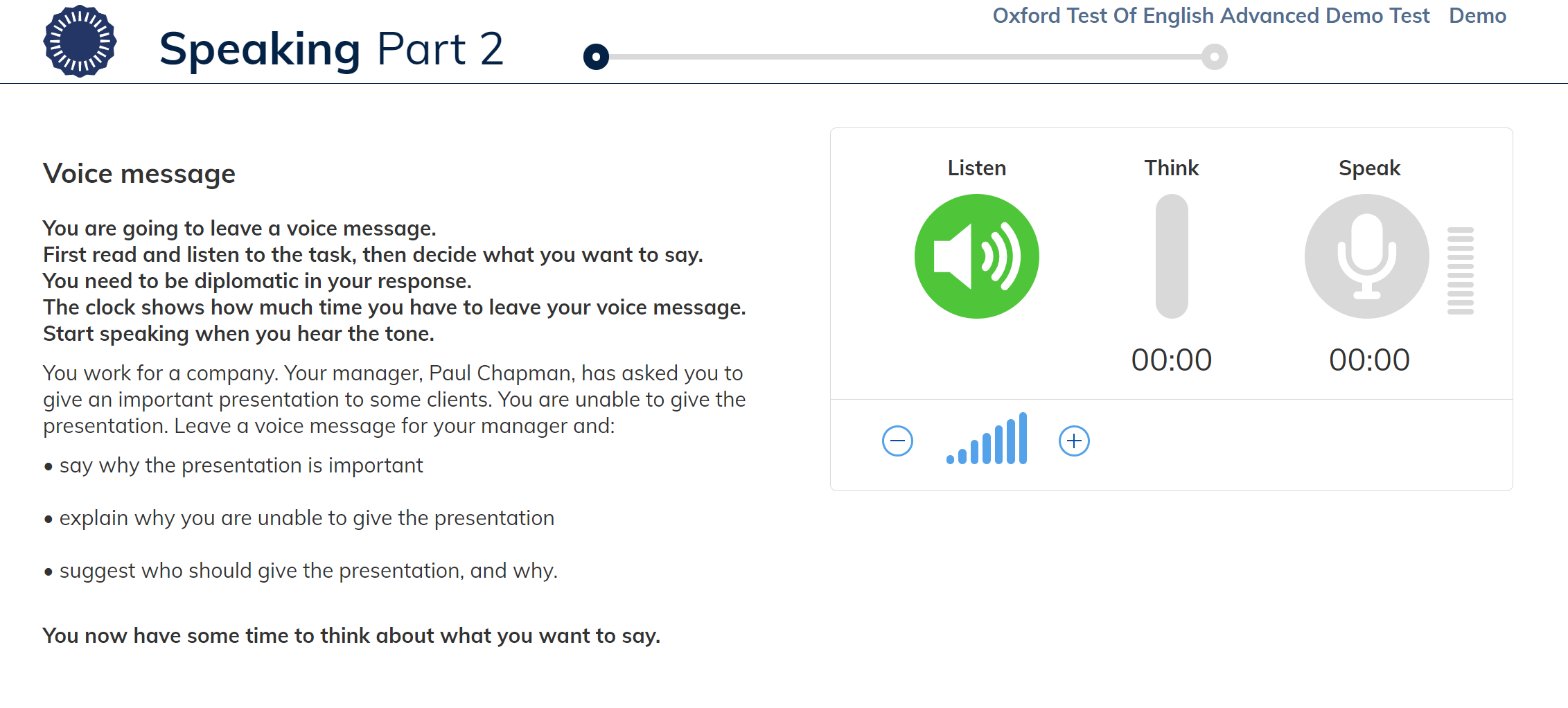
Ejemplo:
You study at college. There have been some issues with one of your tutor’s lectures and this is causing you problems. Leave a voice message for the tutor and:
You now have 30 seconds to think about what you want to say. You can make notes if you wish.
Ve los ejemplos del nivel C1 para ver lo que se espera. Vocabulario típico para este nivel está en negrita.
Task:
You study at college. You had arranged to meet your tutor today to discuss something important but you now have to cancel the meeting. Leave a voice message for your tutor and:
Answer:
Hello Professor Smith,
This is Alex Johnson. I'm calling to inform you that I unfortunately have to cancel our meeting scheduled for today. I've come down with a sudden illness and am unable to attend. I sincerely apologize for any inconvenience this may cause, as I understand the importance of our discussion. It is crucial that we reschedule this meeting as soon as possible because the topic we need to cover is quite urgent for my upcoming project. Please let me know your availability this week, and I'll do my best to accommodate. Thank you for your understanding.
Best regards,
Alex
Tarea: Resumir y sintetizar las ideas principales expresadas en 2 textos de audio sobre un tema complejo.
Audiencia: entorno académico.
Tiempo de preparación: 40 segundos.
Tiempo de respuesta: 50 segundos.
Enfoque: sintetizar información de múltiples fuentes, distinguir puntos principales y detalles de apoyo.
EXPERT 1: [ transcript ]
EXPERT 2: [ transcript ]
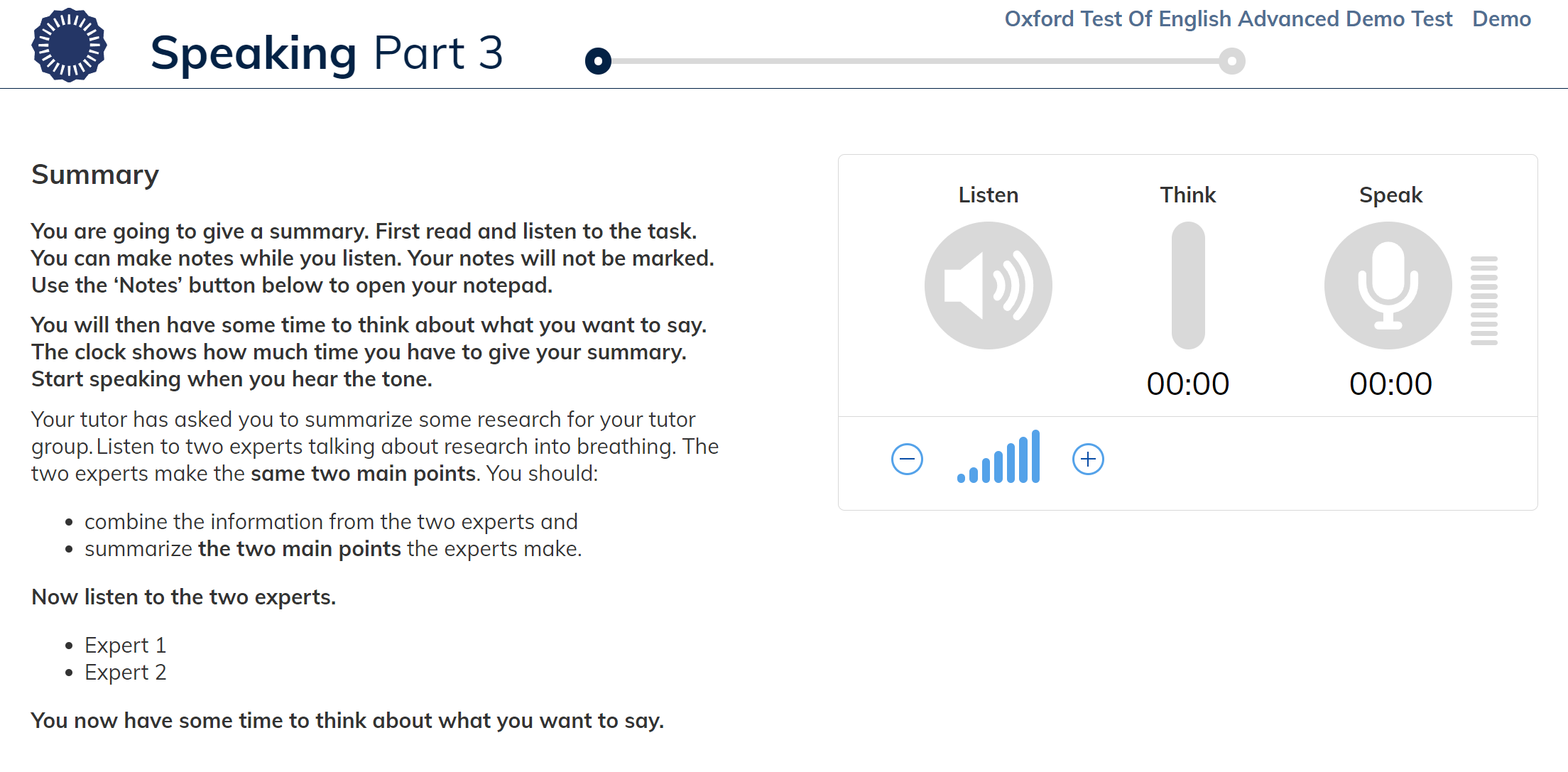
Ejemplo:
You have been discussing the topic of logic on your college course.
Your tutor has asked you to summarize some talks for your tutor group. Listen to two experts talking about logic and summarize the main points that the two experts agree on. You can make notes if you wish. You will hear each expert only once.
You should:
Ve los ejemplos del nivel C1 para ver lo que se espera. Vocabulario típico para este nivel e ideal para el Oxford C1 Exam está en negrita.
Task:
Your tutor has asked you to summarize some research for your tutor group. Listen to two experts talking about maintaining a healthy lifestyle. The two experts make the same two main points. You should:
Answer:
Both experts highlight two main points about maintaining a healthy lifestyle. Firstly, they emphasize the importance of regular physical activity. Speaker 1 mentions that exercise not only improves physical health but also boosts mental well-being. Speaker 2 supports this by stating that consistent physical activity reduces the risk of chronic diseases and enhances mood.
Secondly, both experts stress the importance of a balanced diet. Speaker 1 explains that a diet rich in fruits, vegetables, and whole grains provides essential nutrients and helps maintain a healthy weight. Speaker 2 adds that avoiding processed foods and consuming a variety of nutrients is key to long-term health. Together, these points underline the critical role of exercise and nutrition in maintaining a healthy lifestyle.
Transcripts:
Speaker 1:
Research shows that regular physical activity is crucial for maintaining a healthy lifestyle. It not only improves physical health but also boosts mental well-being. In a recent study, participants who engaged in moderate exercise five times a week reported lower levels of stress and anxiety. Moreover, physical activity has been linked to reduced risks of chronic diseases like diabetes and heart disease.
In addition to exercise, a balanced diet is essential. Consuming a variety of foods, particularly fruits, vegetables, and whole grains, provides the necessary nutrients for the body. This type of diet helps maintain a healthy weight and prevents nutritional deficiencies. Avoiding processed foods and eating a range of nutrients is key to supporting overall health.
Speaker 2:
Maintaining a healthy lifestyle heavily relies on consistent physical activity. Regular exercise not only reduces the risk of chronic diseases but also significantly enhances mood and overall mental health. Engaging in physical activities, such as walking, running, or cycling, can lead to a happier and more fulfilling life.
Equally important is following a balanced diet. A healthy diet that is rich in variety and includes plenty of fresh produce ensures that the body receives all the essential nutrients it needs. Limiting the intake of processed foods and focusing on whole, unprocessed options is critical for long-term health. This combination of exercise and nutrition forms the foundation of a healthy lifestyle.
Tarea: Argumentar a favor o en contra de una propuesta en un debate.
(Instruction: Your tutor has asked you to take part in a class debate. You are going to put a case for or against the following statement: ... )
Audiencia: entorno académico.
Tiempo de preparación: 45 segundos.
Tiempo de respuesta: 2 minutos.
Enfoque: argumentar sobre un tema complejo, estructurar un argumento, formular puntos con precisión, emplear énfasis de manera efectiva.
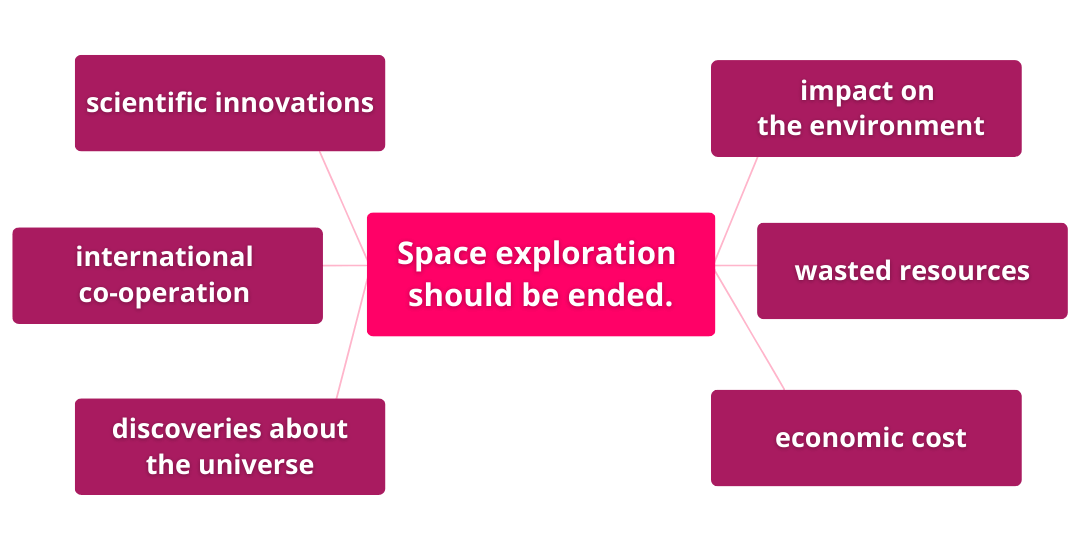
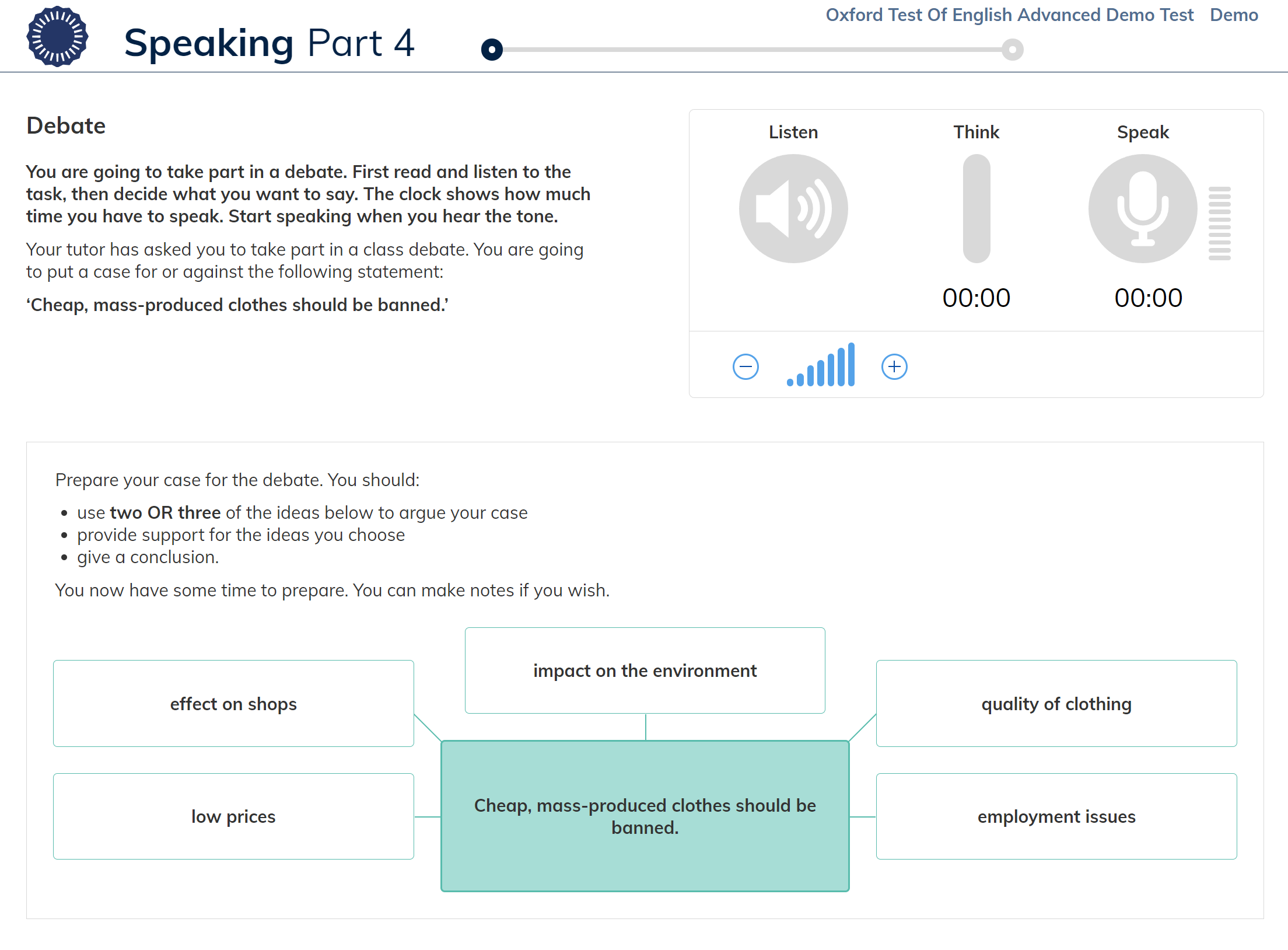
Example:
Space exploration should be ended
Prepare your case for the debate, using the ideas below. You should:
You now have 45 seconds to prepare. You can make notes if you wish.
Ve los ejemplos del nivel advanced de inglés: C1 para ver lo que se espera. Vocabulario típico para este nivel está en negrita.
Task:
Your tutor has asked you to take part in a class debate. You are going to put a case for or against the following statement:
‘Shorter working hours would be a good thing for society.’
Prepare your case for the debate. You should:
Ideas to consider:
Answer:
I am arguing in favor of the statement that shorter working hours would be a good thing for society.
Firstly, shorter working hours would significantly improve work-life balance. In today’s fast-paced world, many people struggle to juggle their professional and personal lives. Reducing working hours would allow individuals to spend more time with their families, pursue hobbies, and engage in community activities. This increased personal time can lead to more fulfilled and happier individuals, thereby strengthening societal bonds.
Secondly, shorter working hours can boost productivity. Research indicates that employees who work fewer hours are often more focused and efficient during their working time. Countries like Sweden, which have experimented with shorter workdays, have reported that employees are not only happier but also more productive. When people are less exhausted and have more energy, they tend to perform their tasks more effectively.
Additionally, there are significant health and well-being benefits to shorter working hours. Prolonged working hours have been linked to stress, burnout, and various health issues, including cardiovascular diseases. By reducing the number of hours people spend at work, we can alleviate these health risks and promote a healthier workforce. Healthier individuals contribute to lower healthcare costs and a more robust society overall.
In conclusion, shorter working hours would greatly benefit society by enhancing work-life balance, increasing productivity, and improving health and well-being. These changes would not only lead to happier individuals but also create a more efficient and healthier society, making it a compelling argument for the adoption of shorter working hours.
Tarea: Responder 4 preguntas cortas relacionadas con la Parte 4 (Debate).
Tiempo de preparación: ninguno.
Tiempo de respuesta: 40 segundos por pregunta.
Enfoque: especular e hipotetizar, hacer comentarios críticos.

Ejemplo:
Your debate was about space exploration.
Ve los ejemplos del nivel C1 para ver lo que se espera. Vocabulario típico para este nivel está en negrita.
Task:
Your tutor has asked you to take part in a class debate. You are going to put a case for or against the following statement:
‘Shorter working hours would be a good thing for society.’
Prepare your case for the debate. You should:
Ideas to consider:
Answer:
I am arguing in favor of the statement that shorter working hours would be a good thing for society.
Firstly, shorter working hours would significantly improve work-life balance. In today’s fast-paced world, many people struggle to juggle their professional and personal lives. Reducing working hours would allow individuals to spend more time with their families, pursue hobbies, and engage in community activities. This increased personal time can lead to more fulfilled and happier individuals, thereby strengthening societal bonds.
Secondly, shorter working hours can boost productivity. Research indicates that employees who work fewer hours are often more focused and efficient during their working time. Countries like Sweden, which have experimented with shorter workdays, have reported that employees are not only happier but also more productive. When people are less exhausted and have more energy, they tend to perform their tasks more effectively.
Additionally, there are significant health and well-being benefits to shorter working hours. Prolonged working hours have been linked to stress, burnout, and various health issues, including cardiovascular diseases. By reducing the number of hours people spend at work, we can alleviate these health risks and promote a healthier workforce. Healthier individuals contribute to lower healthcare costs and a more robust society overall.
In conclusion, shorter working hours would greatly benefit society by enhancing work-life balance, increasing productivity, and improving health and well-being. These changes would not only lead to happier individuals but also create a more efficient and healthier society, making it a compelling argument for the adoption of shorter working hours.
Consiste de 4 partes:
El tiempo en todas las partes del módulo de Listening está predeterminado. Escucharás cada grabación 2 veces y tendrás un tiempo asignado para revisar tus respuestas antes de que el examen avance automáticamente.

Tarea: Escuchar 5 grabaciones de audio y elegir una respuesta (3 opciones).
Tiempo para revisar respuestas: 10 segundos
Enfoque: diferenciar el significado general o un detalle específico
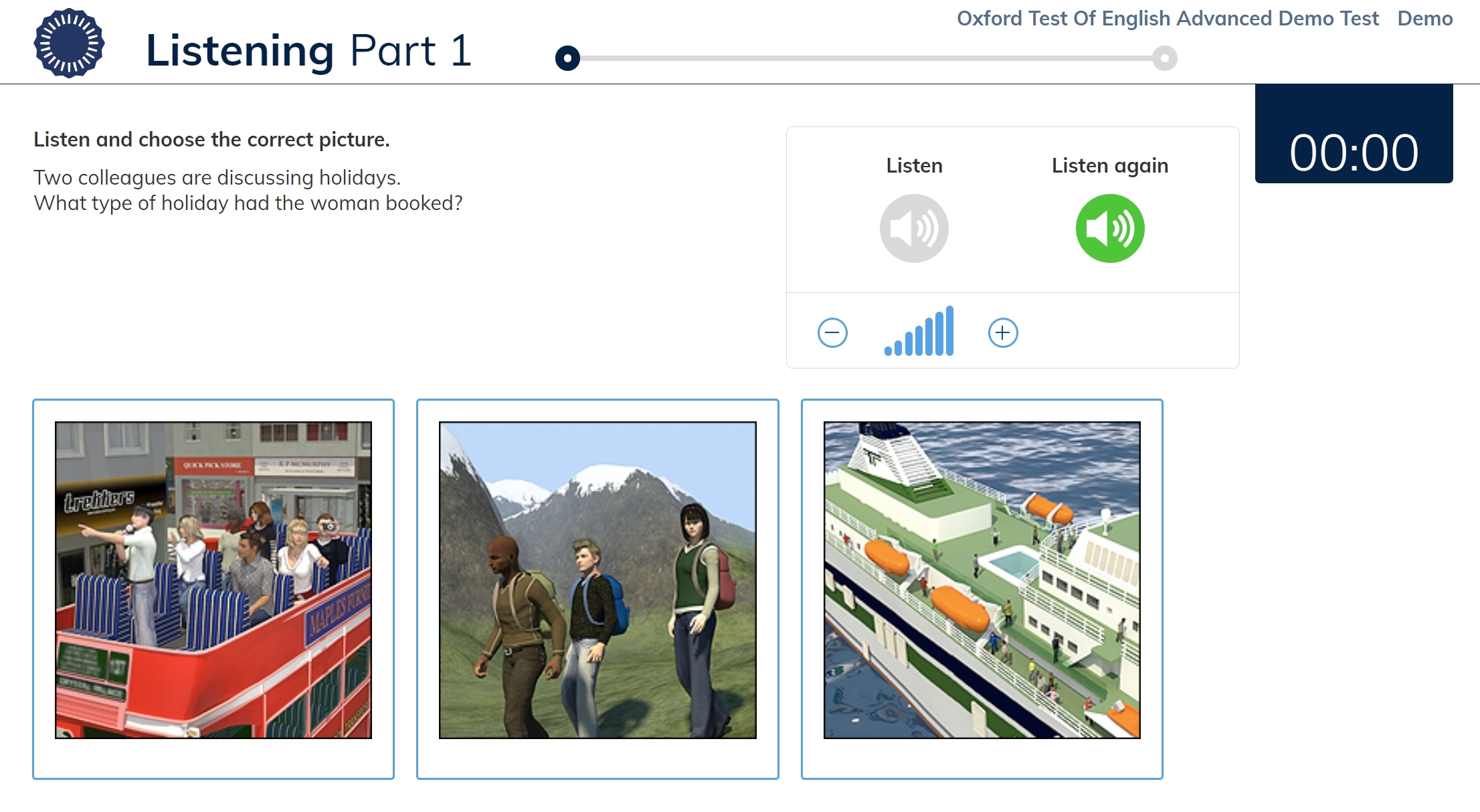
Tarea: Escuchar un monólogo informativo o descriptivo y completar un conjunto de notas que consta de 6 preguntas de respuesta libre.
Tiempo para revisar respuestas: 15 segundos
Enfoque: diferenciar el significado general o un detalle específico
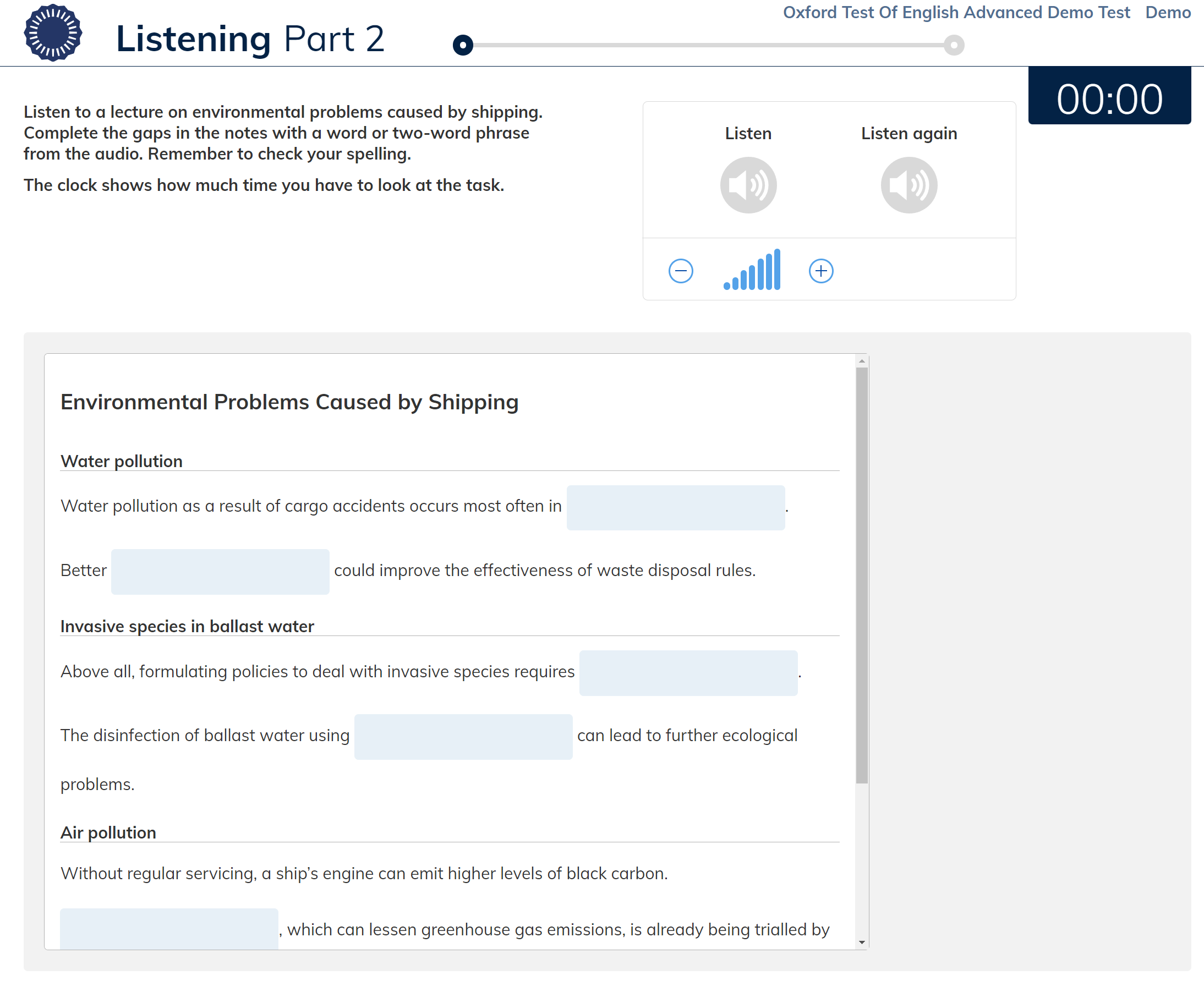
Tarea: Escuchar diálogo extenso para identificar opiniones. 5 preguntas de opción múltiple con 3 opciones (Men, Woman, Both).
Tiempo para revisar respuestas: 15 segundos
Enfoque: identificar opinión expresada o/y significado implícito.
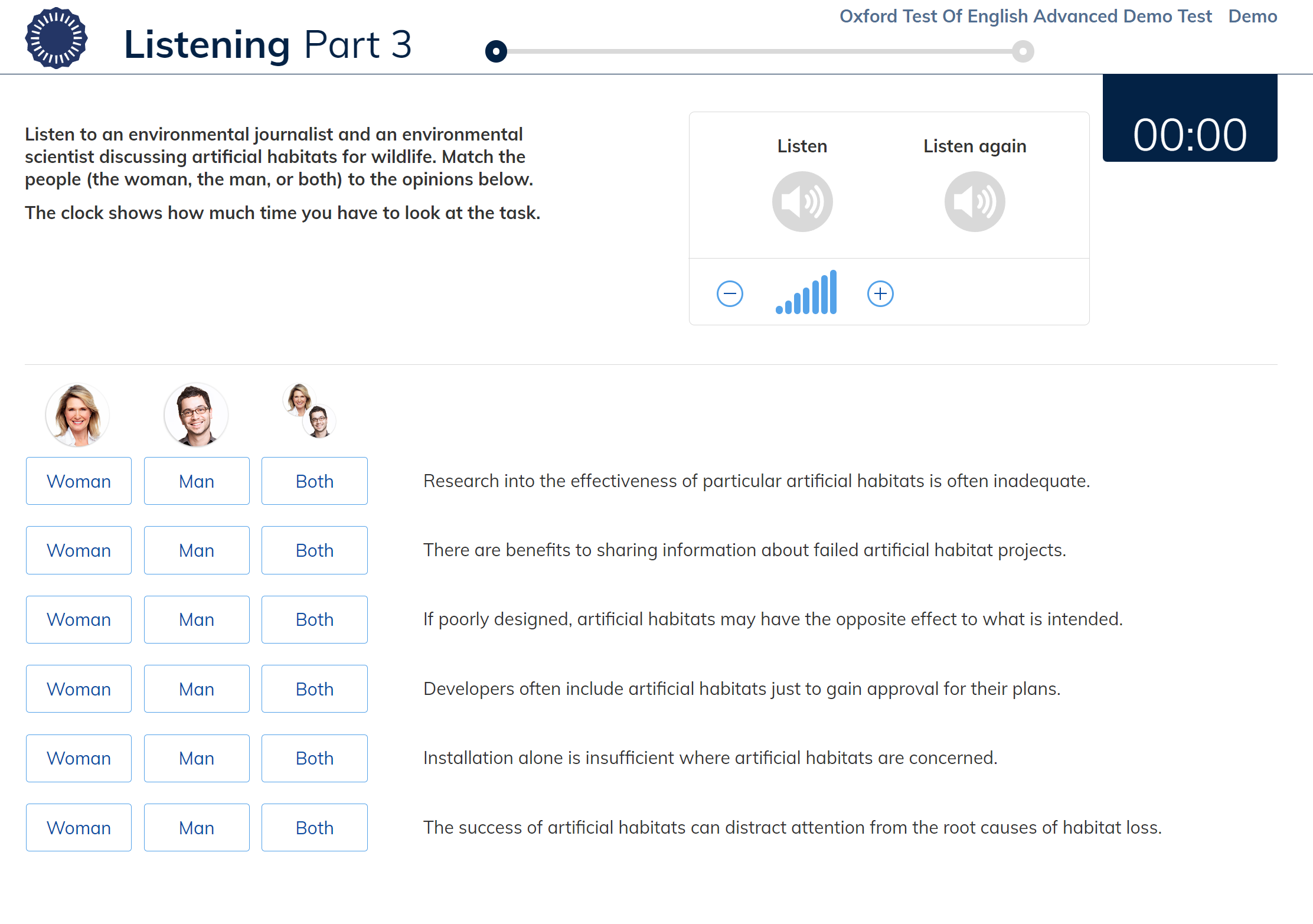
Tarea: Escuchar 5 monólogos/diálogos cortos con 3 opciones de respuesta.
Tiempo para revisar respuestas: 10 segundos
Enfoque: identificar actitud, sentimiento, opinión, idea principal, resumen general, función comunicativa, razón, propósito, tema, género.
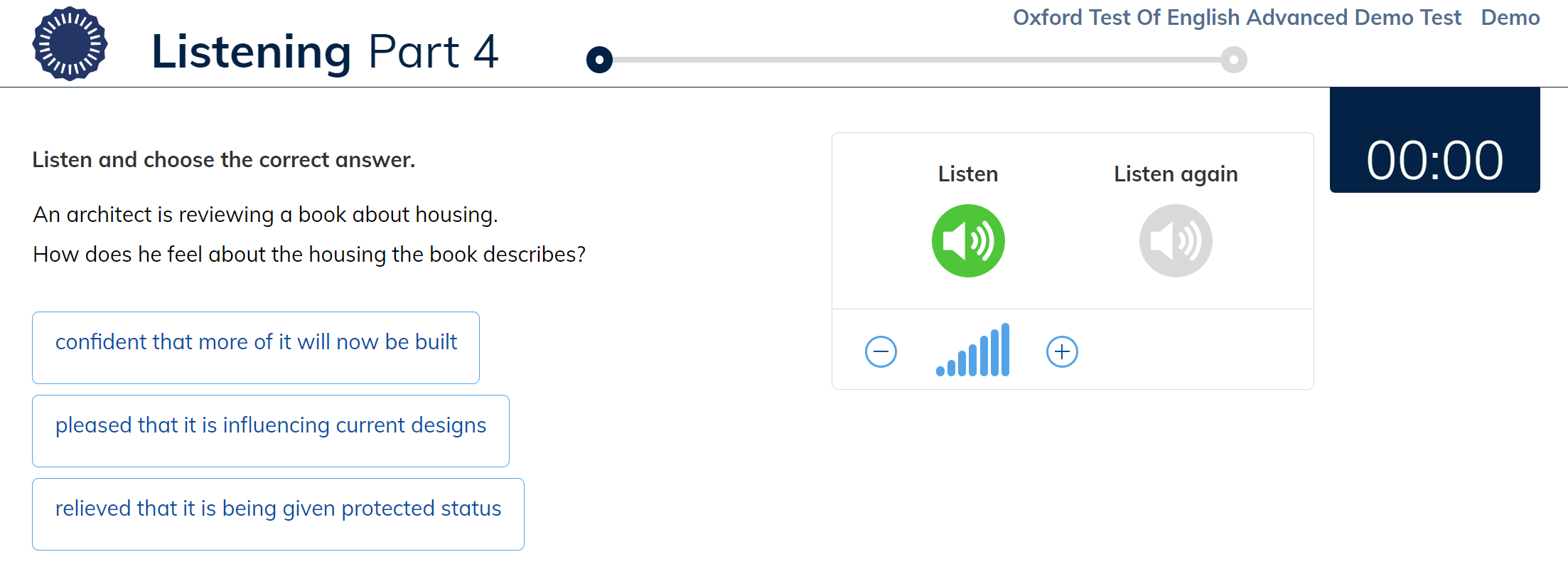
Consiste de 4 partes:
Los textos del módulo de Reading se basan en material auténtico (formal, neutral o informal).
El tiempo permitido para completar cada tarea está predeterminado. Si no se completa a tiempo, el sistema pasa automáticamente a la siguiente tarea.

Tarea: Leer 6 textos cortos de diferentes fuentes (anuncios, blogs, correos electrónicos, notas, avisos y mensajes de texto, extractos de revistas profesionales, extractos literarios, extractos editoriales y extractos de informes.) y responder 6 preguntas de opción múltiple con 3 opciones para cada texto.
Tiempo para responder: 1 minuto 20 segundos (8 minutos en total).
Enfoque: identificar mensaje principal, propósito, detalle.
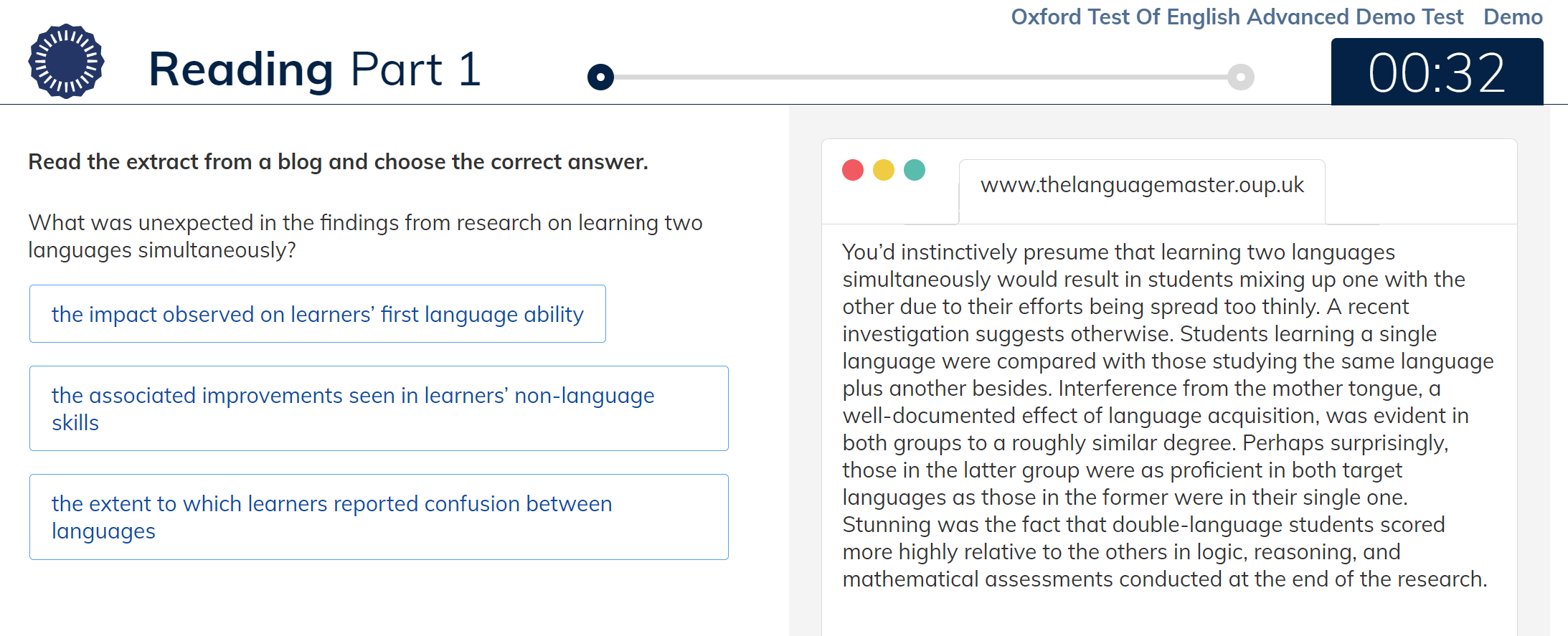
Tarea: Emparejar 3 perfiles de personas con requisitos (por ejemplo, requisitos para un tipo particular de vacaciones) con 7 descripciones.
Tiempo para responder: 8 minutos en total.
Enfoque: significado implícito
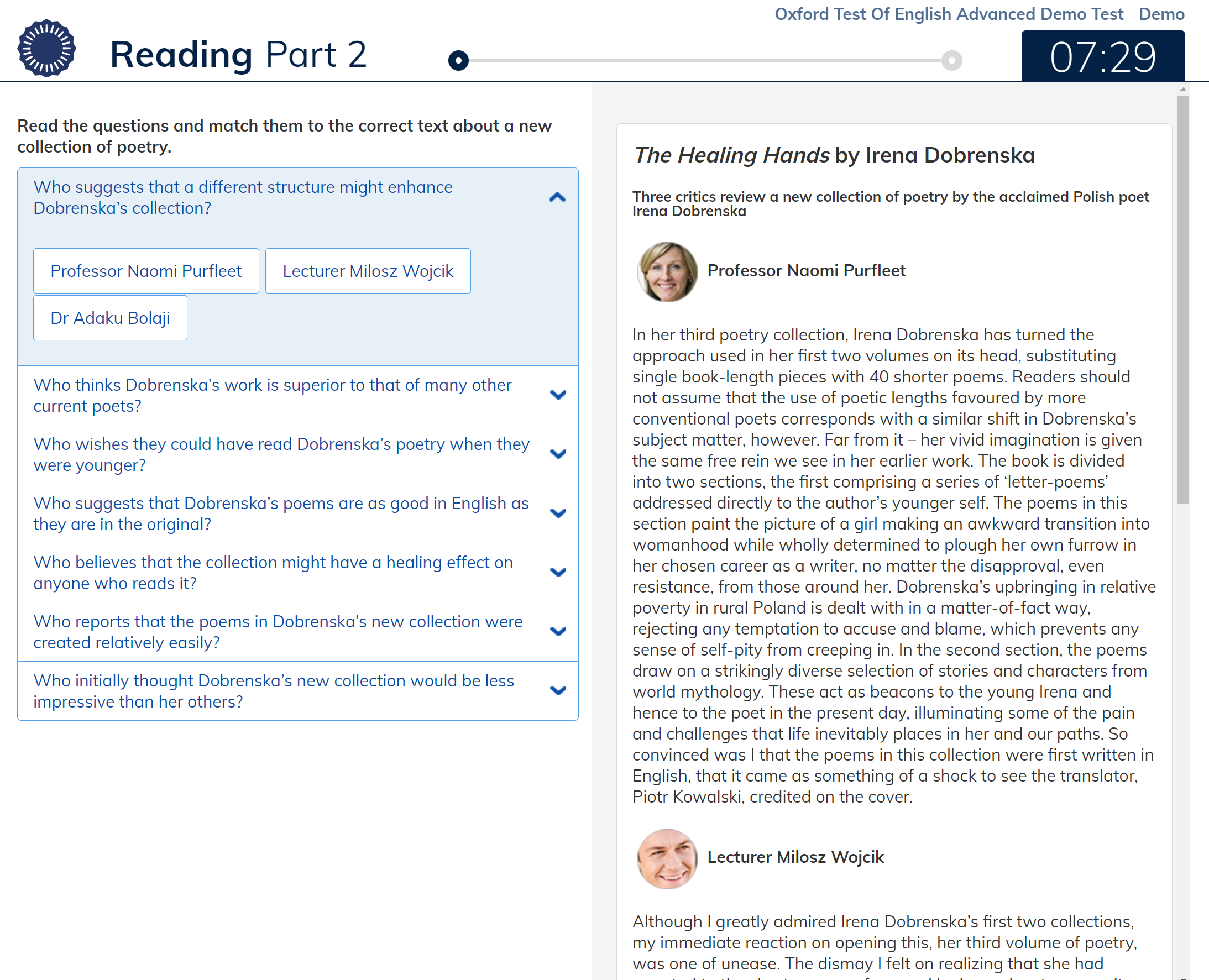
Tarea: Insertar 6 fragmentos extraídos en un texto más largo con 6 huecos (artículos de periódicos y revistas). 8 extractos en total (2 sobrantes)
Tiempo para responder: 11 minutos en total.
Enfoque: identificar la estructura del texto, reconocer las características organizativas de un texto
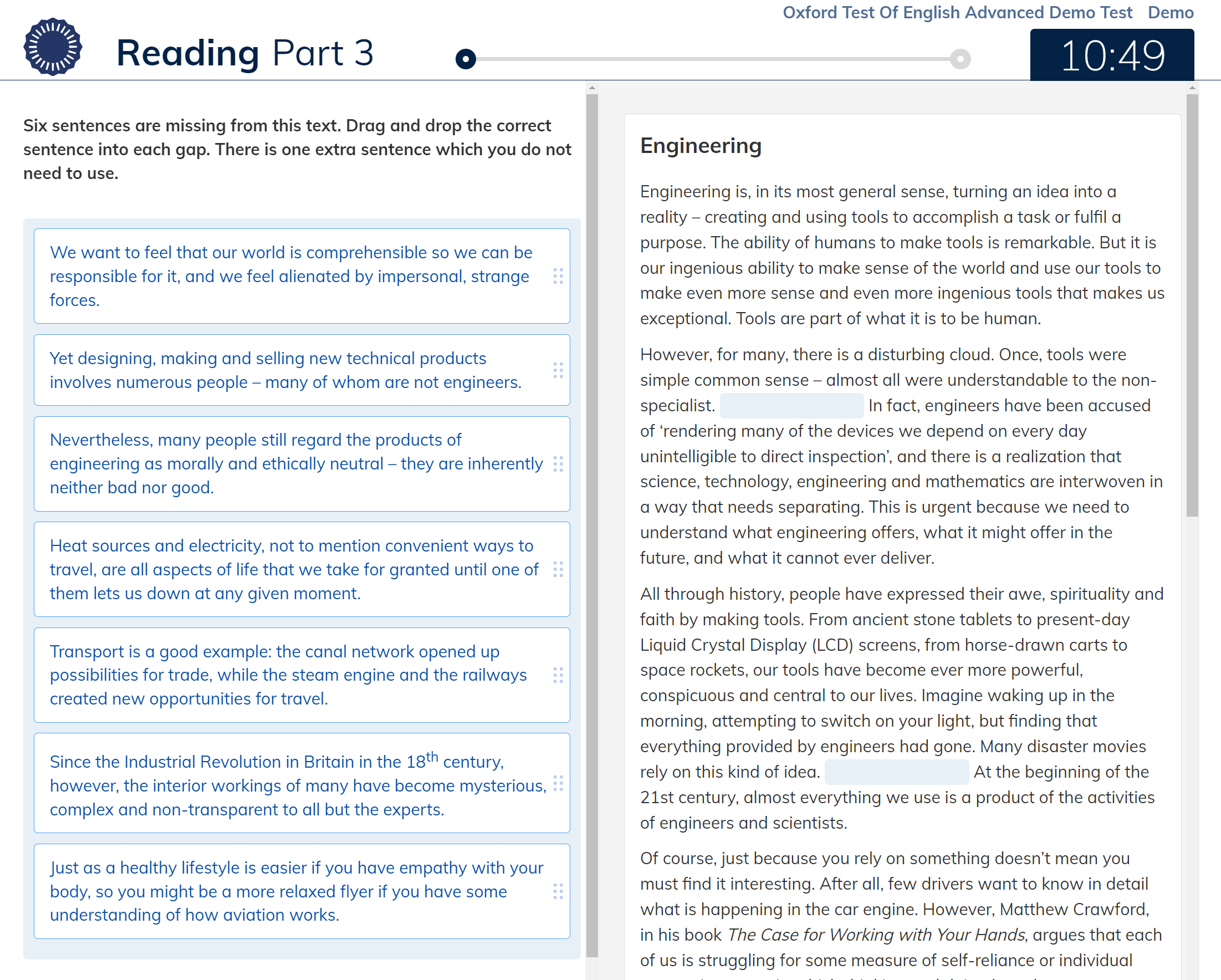
Tarea: 6 preguntas de opción múltiple con 3 opciones. Los textos son de artículos de periódicos y revistas.
Tiempo para responder: 8 minutos en total.
Enfoque: identificar actitud, opinión, propósito, referencia, significado de palabras en contexto, significado global.
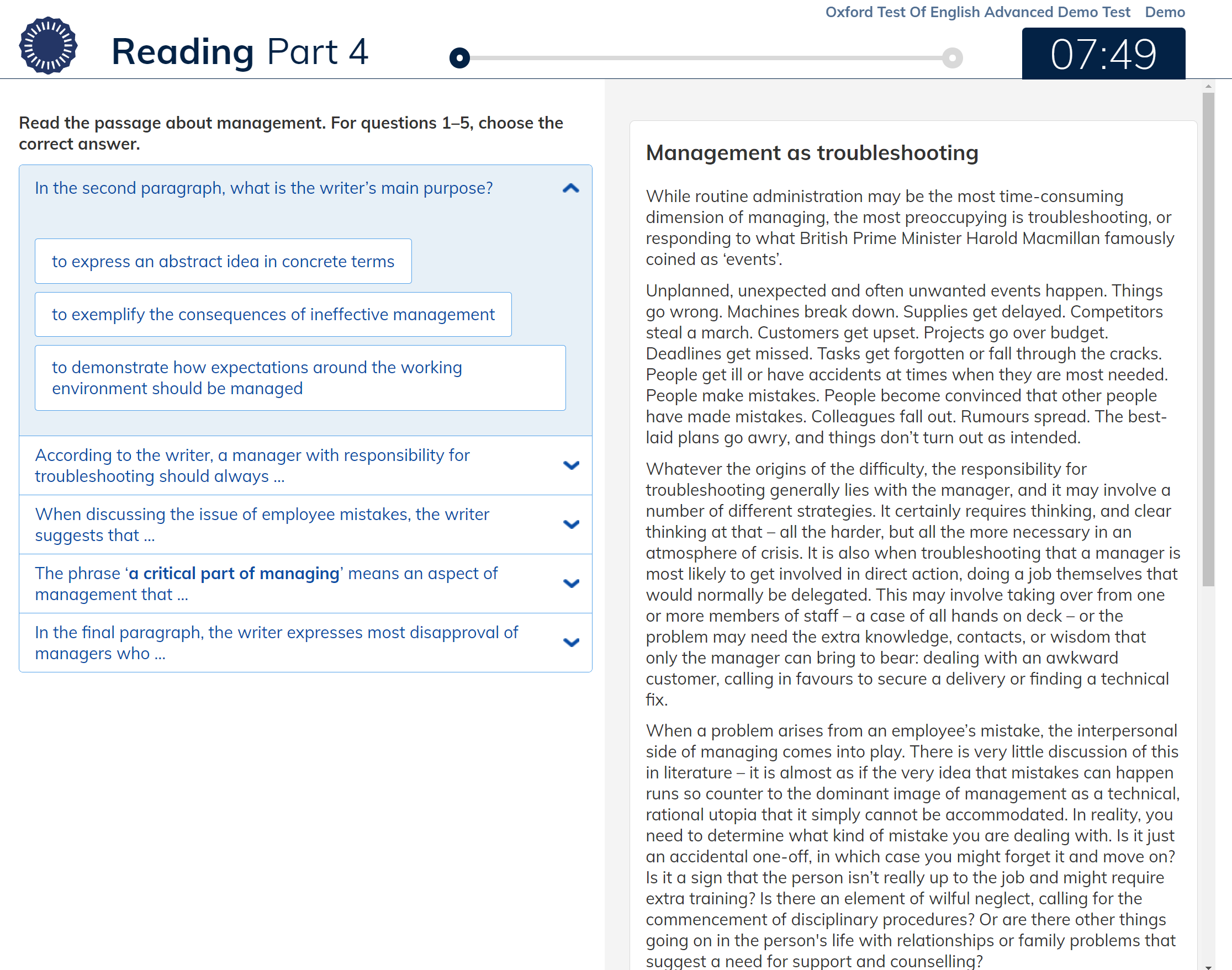
Consiste de 2 partes:
Hay una función automática de conteo de palabras. También hay un reloj para controlar el tiempo de cada parte.

Tarea: Escribir un ensayo en respuesta a una pregunta o declaración. Se presentan tres ideas, de las cuales se deben incluir dos en el ensayo.
Palabras: de 220 a 280
Tiempo de respuesta: 30 minutos
Enfoqué: estructurar un argumento con una introducción y conclusión adecuadas, dar razones a favor o en contra de un punto en particular, evaluar diferentes ideas o soluciones a un problema, destacar cuestiones relevantes.
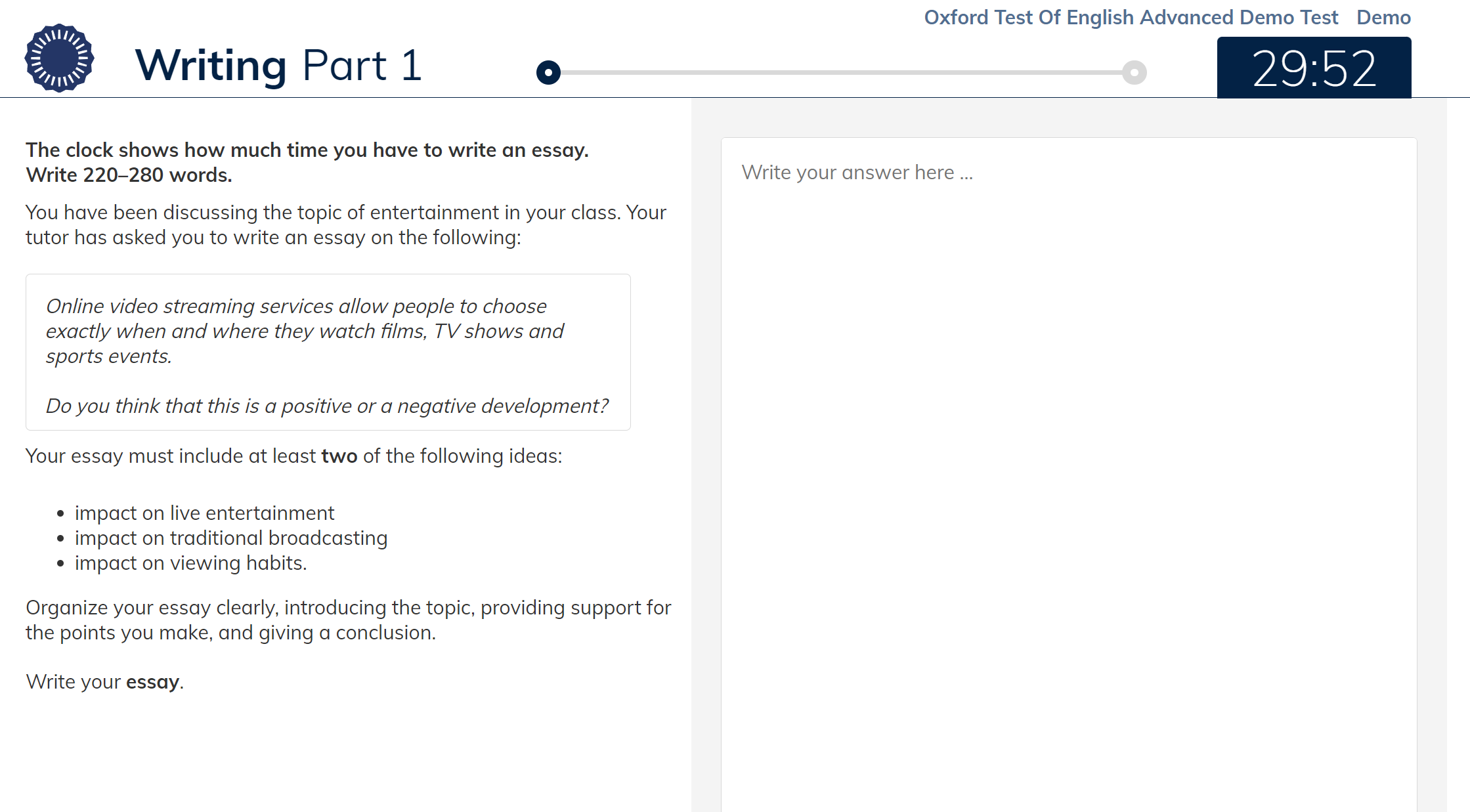
You have been discussing the topic of technology in your class. Your tutor has asked you to write an essay on the following:
The modern computer has given people more opportunities than ever before. Do the advantages of this development outweigh the disadvantages?
Your essay must include 2 of the following:
• education • work • health
Vocabulario típico para el nivel C1 ha sido marcado en negrita.
The modern computer has given people more opportunities than ever before. Do the advantages of this development outweigh the disadvantages?
The advent of the modern computer has undeniably revolutionized various facets of human life, offering a plethora of opportunities that were previously unimaginable. This essay will examine how the integration of computers in education and work has brought significant advantages, which, I argue, outweigh the disadvantages.
Firstly, the role of computers in education has been transformative. E-learning platforms and digital resources have made education more accessible and flexible. Students can now access a vast array of information and learning materials from anywhere in the world, breaking down geographical barriers that once hindered education. Facilitating interactive learning through multimedia presentations and educational software, computers can enhance understanding and retention of information. While critics argue that excessive screen time can lead to distractions and reduced physical activity, the overall impact on educational opportunities is profoundly positive. Had computers not become widespread, we would not have witnessed such democratization of education. The ability to learn at one's own pace and the democratization of education outweigh these potential drawbacks, making it a game-changer in the field of learning.
In the realm of work, computers have dramatically increased productivity and efficiency. Automation and digital tools allow for the completion of tasks with greater speed and accuracy, freeing up time for employees to focus on more strategic and creative endeavors. Additionally, computers enable remote work, offering flexibility that can lead to a better work-life balance. This was particularly evident during the COVID-19 pandemic, where many businesses continued operations thanks to computer technology. Had it not been for computers, many companies would have faced severe operational challenges. Although there are concerns about job displacement due to automation and the erosion of boundaries between work and personal life, the benefits, such as increased flexibility and improved efficiency, are substantial. Being able to work remotely, employees can achieve a more balanced lifestyle, thereby enhancing overall job satisfaction.
In conclusion, while the rise of the modern computer does come with certain disadvantages, such as potential job displacement and health issues related to excessive screen time, the advantages in education and work are significant. The ability to access education from anywhere and the increased productivity and flexibility in the workplace highlight the positive impact of computer technology on modern life. All things considered, the opportunities provided by modern computers far outweigh their drawbacks, heralding a more connected and efficient future.
Tarea: Leer dos textos sobre el mismo tema y resumir las ideas principales en un sólo párrafo, sintetizando la información de ambos textos.
Audiencia: entorno académico.
Palabras: de 80 a 100 palabras
Tiempo de respuesta: 20 minutos
Enfoque: sintetizar información de múltiples fuentes, distinguir los puntos principales y los detalles de apoyo.
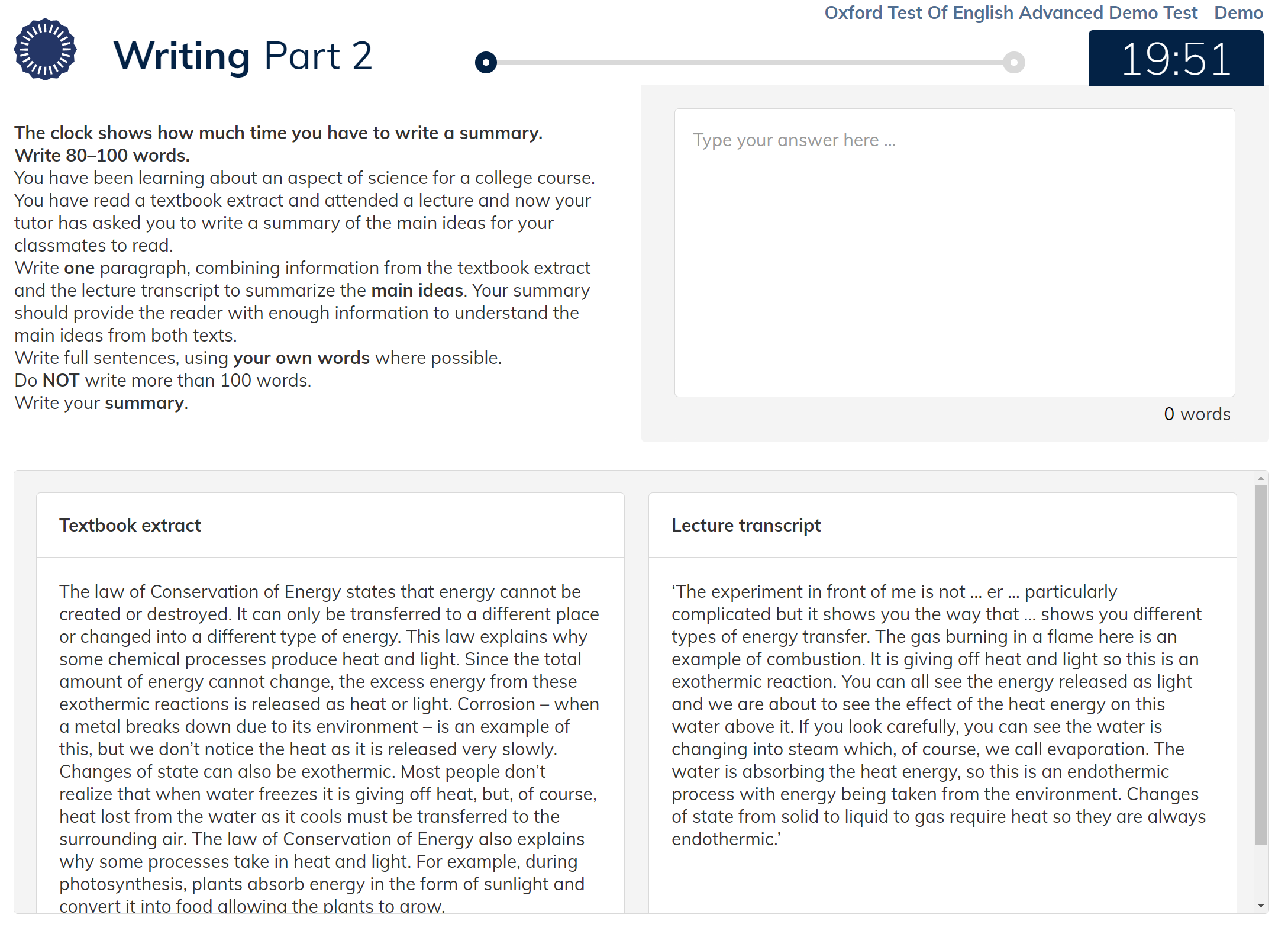
You have 20 minutes to write a summary. Write 80–100 words. You have been learning about psychology in a college class. Your tutor has now asked you to read about research in psychology and write a summary of the main ideas to share with your class.
Read the two texts below and write one paragraph using full sentences, combining the information given in the texts. Use your own words where possible. Your summary should provide the reader with enough information to understand the main ideas in the texts.
Do NOT write more than 100 words.
Write your summary.
In theory, when researchers conduct research, their experiments are fair and provide valid results. In practice, the research results can be negatively affected in various ways. One common cause of unfairness, or bias, is the researcher themselves. For example, a researcher can make mistakes when recording results. This is referred to as the ‘experimenter effect’ as it is the experimenter that affects the outcome of the experiment, reducing confidence in the experiment’s result. There are two main kinds of experimenter effect. First, let’s turn to non-interactional effects. These are found in research that does not require the researcher to interact with the research subjects, for example where the researcher does not record accurately what they have observed, known as the Observer Effect. Less common are Intentional Effects, where researchers do not report the research results accurately on purpose.
“Ok, so back in the late sixties, a leading psychologist conducted an experiment into a type of researcher bias called ‘Interactional Effects’, that’s to say, ones that involve the researcher interacting with the subject. Two teams of researchers were set up, each given a maze containing rats to observe. One team was told they had intelligent rats; the other team were told they’d got unintelligent rats. The intelligent rats solved the maze well while the unintelligent rats didn’t. What makes this surprising is that the rats, in fact, were all equally intelligent! That’s a classic case of the ‘expectancy effect’, where the researcher unconsciously influences the subject to act how the researcher wants them to, making the research less valid. Don’t confuse that with the ‘Interpreter effect’, a non-interactional effect where the researcher interprets the evidence from an experiment incorrectly. Anyway, it’s believed the ‘intelligent’ rats did better because the researchers with the ‘intelligent’ rats treated them better than those with ‘unintelligent’ rats.”
Example Answer:
Psychological research is often compromised by researcher bias, which can undermine the validity of results. This bias manifests in several ways. The textbook describes two primary types: non-interactional effects, such as the Observer Effect, where researchers inaccurately record observations, and intentional effects, where results are deliberately misreported. Additionally, the lecture highlights interactional effects, demonstrated by an experiment where researchers' expectations influenced the behavior of rats in a maze, a phenomenon known as the 'expectancy effect.' This shows how researcher interaction can unconsciously affect the subjects, making research outcomes less reliable.
Empieza abordando el tema general y el problema central. Aquí, el foco principal es el sesgo del investigador en el campo de la investigación psicológica.
Consejo: Emplea términos generales para preparar el terreno antes de proporcionar información más detallada.
Resume los diversos tipos de sesgo discutidos en el libro de texto.
Consejo: Diferencia claramente entre los distintos tipos de efectos, aportando ejemplos específicos cuando sea posible. Utiliza frases como "dos tipos principales" para estructurar la información de manera lógica.
Resume el ejemplo clave y los hallazgos presentados en la conferencia.
Consejo: Enfatiza el experimento específico y sus resultados. Frases como "demostrado por un experimento" pueden conectar la teoría con ejemplos prácticos.
Explica cómo los ejemplos de ambas fuentes están relacionados con el tema general del sesgo del investigador.
Consejo: Utiliza palabras de transición como "además" y "esto muestra" para conectar suavemente la información de ambas fuentes.
Reafirma brevemente el impacto de los sesgos identificados en la validez de la investigación.
Consejo: Termina con una declaración que refuerce el problema principal discutido, asegurando que tu resumen se sienta completo.
Necesitas por lo menos un 50% para aprobar. Pero no te preocupes demasiado por eso, porque este test está diseñado de una manera especial. Utiliza un algoritmo que se ajusta a tu nivel.
¿Cómo funciona? Muy sencillo: si respondes bien una pregunta, la siguiente será un poco más difícil. Si te equivocas, la siguiente será más fácil. Así, el test siempre te está desafiando justo en tu nivel. Al final, esto permite que el test sepa exactamente cuál es tu verdadero nivel de inglés.
Entonces, relájate y confía en el proceso. Este tipo de test está hecho para darte una evaluación precisa y personalizada, asegurando que cada pregunta que respondas sea adecuada para ti. ¡Buena suerte!
Alex Bell, con más de una década de experiencia, es una destacada profesora y examinadora para certificaciones de inglés de prestigio como Oxford y Cambridge. También lidera como Test Manager en el Centro Examinador de Oxford, aportando su vasta experiencia en la preparación eficaz de estudiantes para sus certificaciones.




